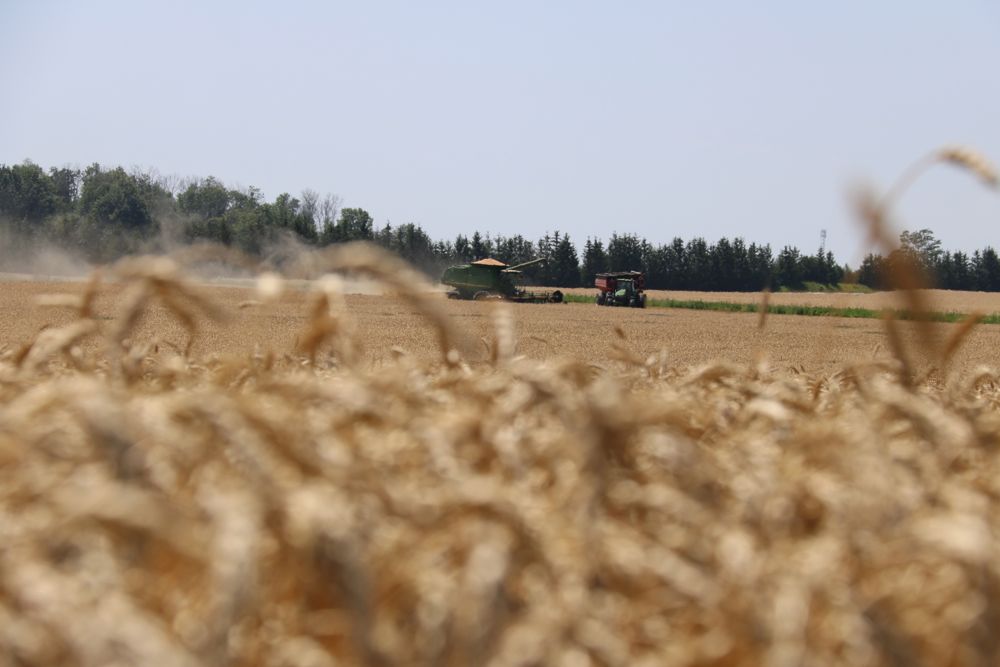Corn and soybeans have been the big winners in the race to introduce new seed treatments. In the past 10 years, eastern Canadian farmers have got Poncho for their corn, while soybean growers have been basking in the positive effects of CruiserMaxx Beans, as well as the expanding market for inoculants.
But what about cereals? And, more specifically, what about wheat?
In earlier years, after all, the cereal sector had been the focus of innovation in seed treatments, starting with Dividend in winter wheat roughly 15 years ago. That was seen as something of a revolutionary move, with Raxil MD and several others entering the market shortly after.
Read Also

Could crop sharing be a viable option for your farm?
Crop sharing could be a good option for young and beginning farmers.
Now, C&M Seeds, based near Palmerston, Ont., is testing a combination of CruiserMaxx Cereals plus Proseed. According to Ellen Sparry, who is in charge of the company’s research and development, and Rob McLaughlin, district sales manager, this combination is still very new. C&M has only been testing CruiserMaxx on its cereal varieties for the past five years, while Sparry notes she first learned of Proseed a mere three years ago.
“We had been testing CruiserMaxx Cereals but hadn’t actually seen much on Proseed, yet we were excited that there was a product to help with fusarium, because it had become an issue with spring and winter wheat,” says McLaughlin. “We’ve had the right weather conditions, especially in eastern Ontario, which is a huge spring wheat market, for almost three years straight.”
At the 2011 Outdoor Farm Show, near Woodstock, Ont., C&M Seeds featured a display at its tent based around three environment-controlled glass tanks containing plots of spring wheat. One was an untreated check while the second was treated with Dividend XL and the third with CruiserMaxx Cereals plus Proseed.
What surprised C&M employees is that different people saw different things from the same display.
“One person would say that the roots seemed to have more mass to them, another one would say the roots go deeper, and then some would say that there was taller growth on the top,” says McLaughlin. “They were obviously looking at different aspects and seeing what they liked.”
The results
From an R&D perspective, the results that Sparry and McLaughlin observe in their plots are mainly below ground, namely a better environment for the crop to develop as well as better hardiness so the crop can defend itself against stress.
In the case of winter wheat, the two found the CruiserMaxx treatment (a blend of thiamethoxam, mefenoxam and difenconazole) created a better root mass, enabling the plant to withstand the tough winter conditions and get off to a faster start in the spring.
“Even in the spring cereals, just from my own research trials, whether it’s the fact that seed is going in to cooler conditions, certainly there’s a yield advantage, and it seems a big yield advantage with the spring cereals, but also with the winters as well,” says Sparry.
In fact, the increases in yield that they are seeing with test plots as well as in yield competitions have been enough to convince C&M Seeds to treat all spring wheats with CruiserMaxx and Proseed. In the yield competition for spring wheats in 2011, the winners were 98, 92 and 91 bushels. Overall, in their five-year tests, they have seen larger yield boosts in the spring varieties compared to the winters.
“I know we have not had those numbers in the past (in spring wheat varieties), and I would like to attribute some of that, not only to genetics, but I believe the seed treatments play a big part in that as well,” says McLaughlin.
McLaughlin emphasizes the importance of Proseed (a mix of fludioxonil and metalaxyl-M) in the seed treatments, particularly because of its mode of action on fusarium. But there is also a timing benefit with the seed treatment.
When a crop has uneven emergence, its application window for fusarium fungicides actually shrinks. It’s because there are fewer days when the crop is at the right stage without some plants being too mature and others not mature enough.
Having a seed treatment that helps every kernel come out of the ground at the same time, by contrast, will produce a more uniform crop, which then extends the application window and helps with the overall fusarium management strategy because all the plants can be at their optimum stage when the application is made.
So if they plan to apply a fungicide such as Prosaro or Folicur, a seed treatment that gives uniform emergence is the first step for disease success.
“With new seed treatments, if you’re getting more plants at the right stage at the right time, it’s going to change that application stage as well. It’s going to help that,” says McLaughlin. “It’s definitely something that growers are seeing. It’s not all based on yield payback, but quality can be drastically affected by how the crop gets out of the ground.”
Pushing wheat
One other issue where CruiserMaxx is helping is with later-planted winter wheat. With strong soybean pricing, farmers are opting for longer-season varieties, which means the following wheat crop may struggle its way into the cold weather.
At the 2012 Southwest Agricultural Conference in Ridgetown, that very subject was raised during a presentation on boosting soybean yields. Although it may seem to make financial sense to push soybean maturities, the expert consensus was that delaying planting on winter wheat can compromise emergence, plant health, winter survivability and even how the crop will perform against fusarium the following spring.
“Given the weather conditions we’ve had in the past couple of years, certainly seed treatments on that winter wheat not planted at optimum timing or conditions is a good choice,” says Sparry.
McLaughlin agrees. “Wheat’s competitive with corn right now,” he adds. “So if you look at the total picture, going for a better wheat crop in combination with a good soybean crop is your best option.” CG















